Business IT Report: Analysis of POS Systems for Small Businesses
VerifiedAdded on 2020/05/28
|11
|2205
|117
Report
AI Summary
This report provides a comprehensive analysis of Point of Sale (POS) systems within the context of small and medium-sized businesses. It explores the advantages of POS systems, such as web-based installation, time-saving transactions, and efficient record-keeping, while also addressing potential disadvantages like connection reliability issues, upgrade costs, and security risks. The report delves into the competitive advantages gained through POS implementation, including improved sales tracking, efficient inventory management, and faster transactions. It further discusses the benefits of a centralized database, the effective use of POS systems for decision-making, and recommended telecommunication options, including LAN and wired technologies. Finally, the report highlights the various types of risks associated with POS systems, such as security, privacy, and confidentiality, and offers recommendations to mitigate these risks, concluding with a call for businesses to carefully consider these factors when implementing a POS system to optimize their operations.
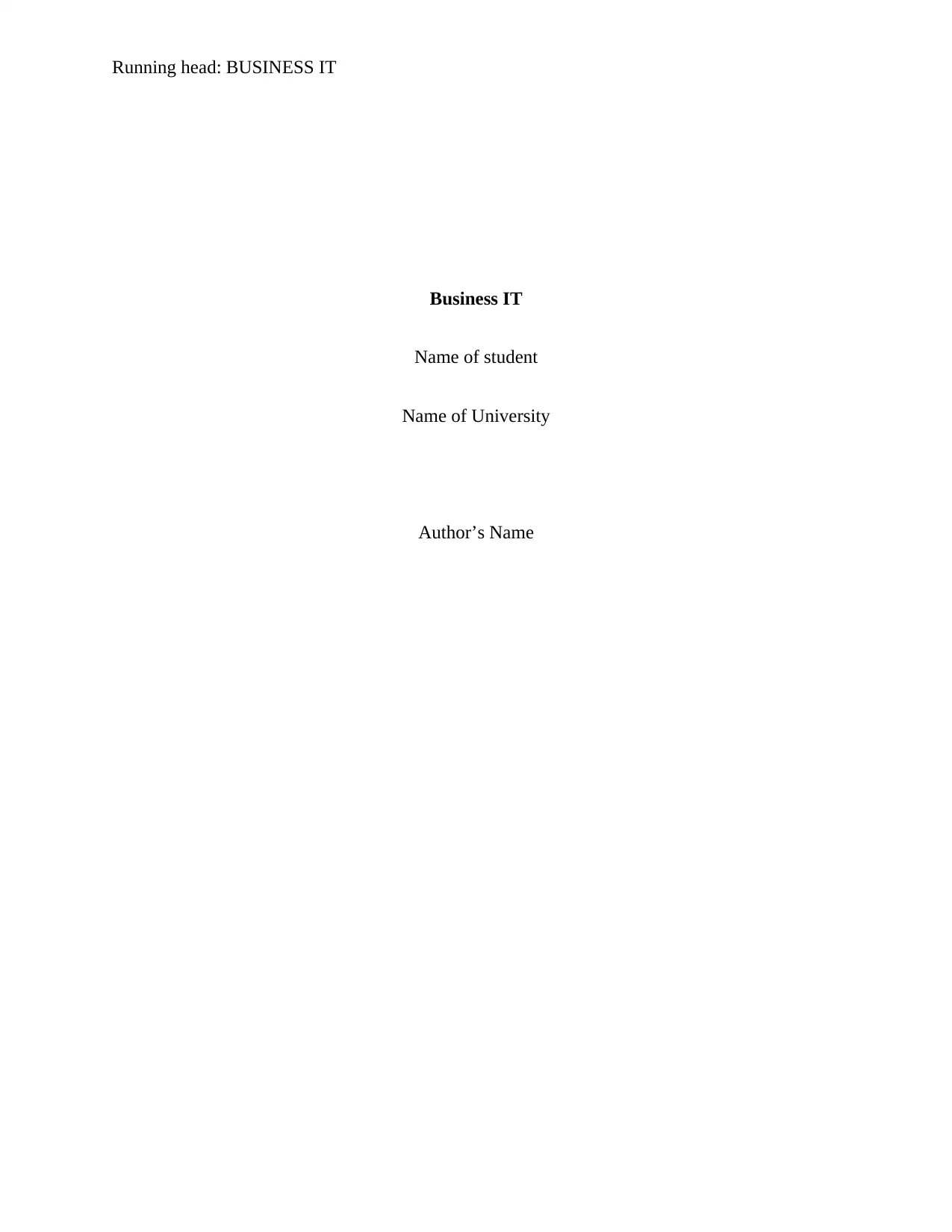
Running head: BUSINESS IT
Business IT
Name of student
Name of University
Author’s Name
Business IT
Name of student
Name of University
Author’s Name
Paraphrase This Document
Need a fresh take? Get an instant paraphrase of this document with our AI Paraphraser
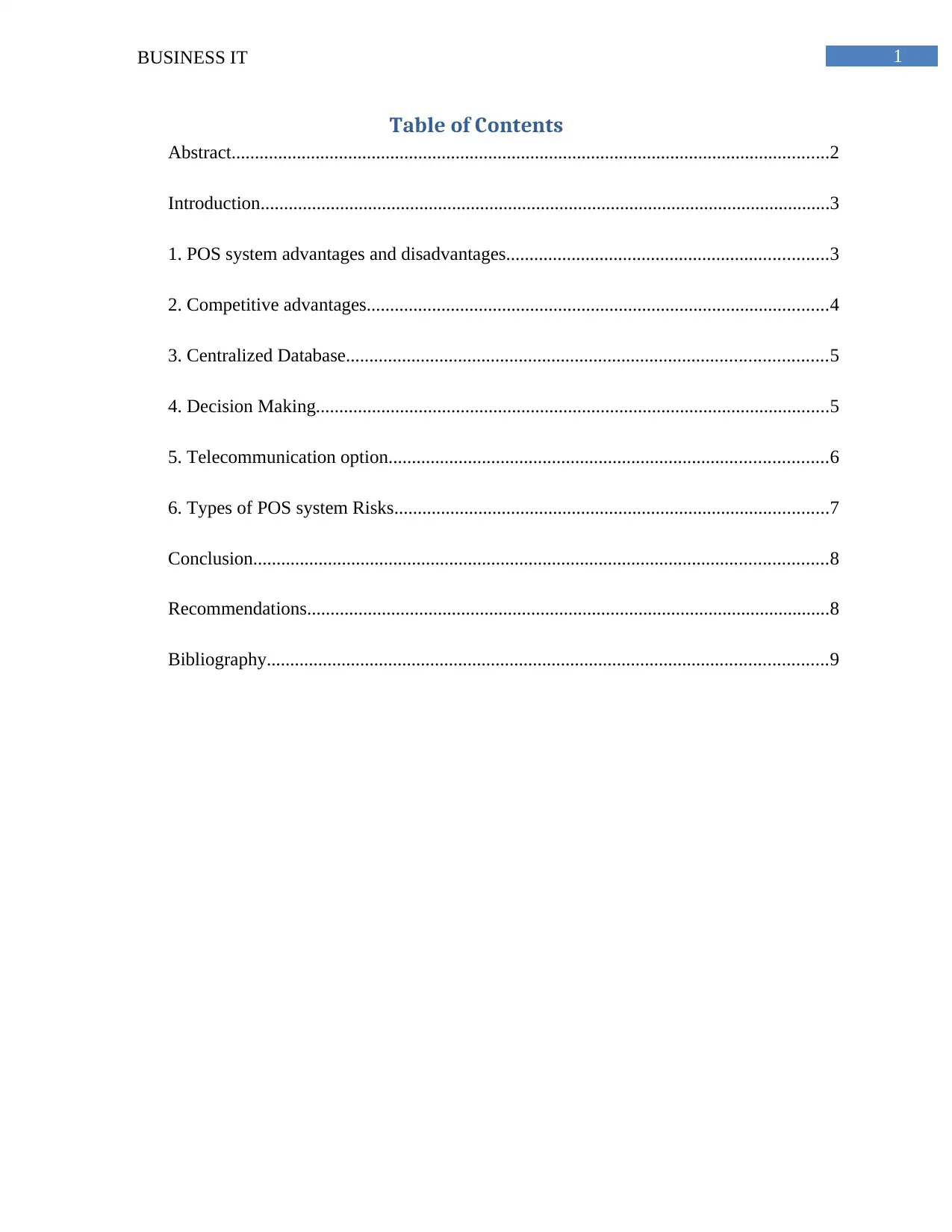
1BUSINESS IT
Table of Contents
Abstract................................................................................................................................2
Introduction..........................................................................................................................3
1. POS system advantages and disadvantages.....................................................................3
2. Competitive advantages...................................................................................................4
3. Centralized Database.......................................................................................................5
4. Decision Making..............................................................................................................5
5. Telecommunication option..............................................................................................6
6. Types of POS system Risks.............................................................................................7
Conclusion...........................................................................................................................8
Recommendations................................................................................................................8
Bibliography........................................................................................................................9
Table of Contents
Abstract................................................................................................................................2
Introduction..........................................................................................................................3
1. POS system advantages and disadvantages.....................................................................3
2. Competitive advantages...................................................................................................4
3. Centralized Database.......................................................................................................5
4. Decision Making..............................................................................................................5
5. Telecommunication option..............................................................................................6
6. Types of POS system Risks.............................................................................................7
Conclusion...........................................................................................................................8
Recommendations................................................................................................................8
Bibliography........................................................................................................................9
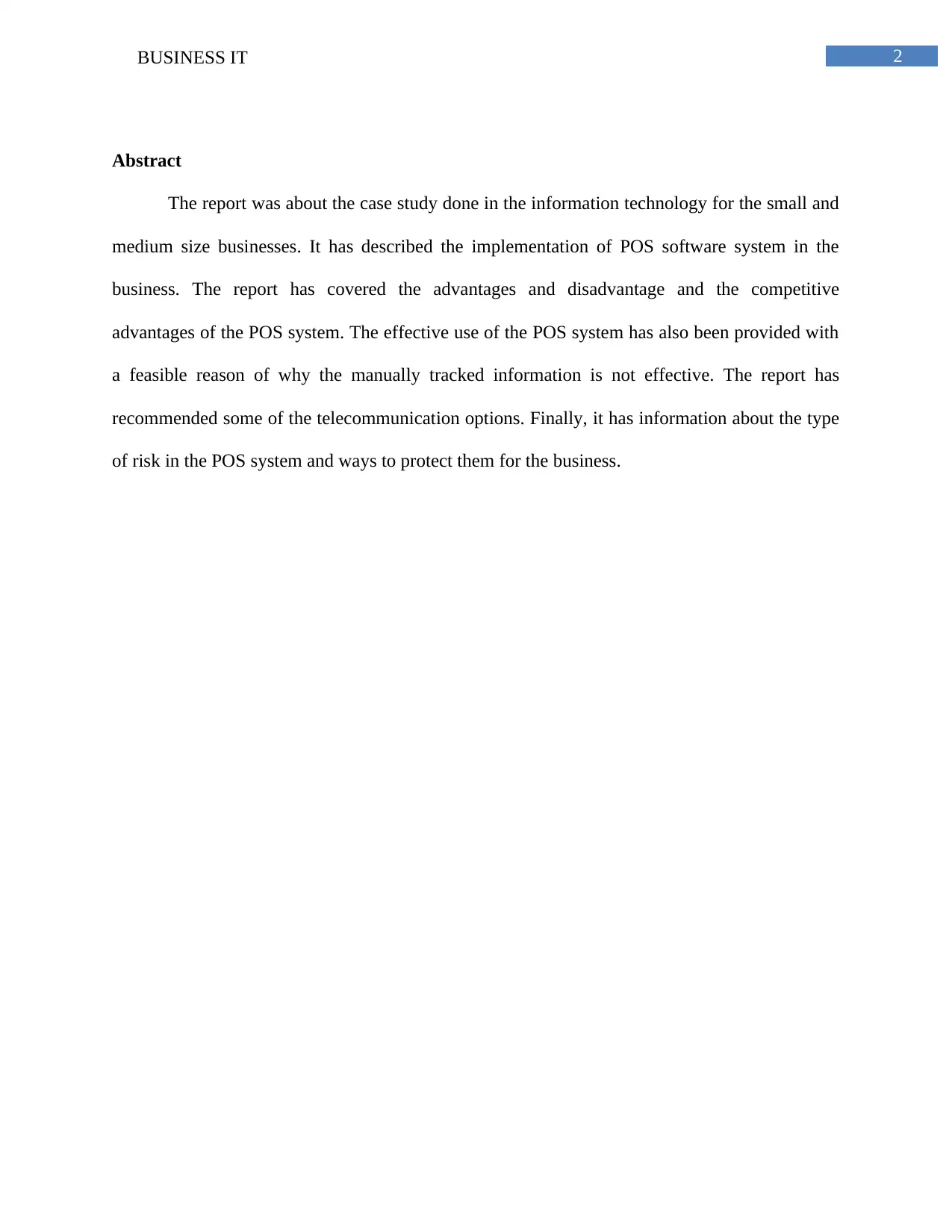
2BUSINESS IT
Abstract
The report was about the case study done in the information technology for the small and
medium size businesses. It has described the implementation of POS software system in the
business. The report has covered the advantages and disadvantage and the competitive
advantages of the POS system. The effective use of the POS system has also been provided with
a feasible reason of why the manually tracked information is not effective. The report has
recommended some of the telecommunication options. Finally, it has information about the type
of risk in the POS system and ways to protect them for the business.
Abstract
The report was about the case study done in the information technology for the small and
medium size businesses. It has described the implementation of POS software system in the
business. The report has covered the advantages and disadvantage and the competitive
advantages of the POS system. The effective use of the POS system has also been provided with
a feasible reason of why the manually tracked information is not effective. The report has
recommended some of the telecommunication options. Finally, it has information about the type
of risk in the POS system and ways to protect them for the business.
⊘ This is a preview!⊘
Do you want full access?
Subscribe today to unlock all pages.

Trusted by 1+ million students worldwide
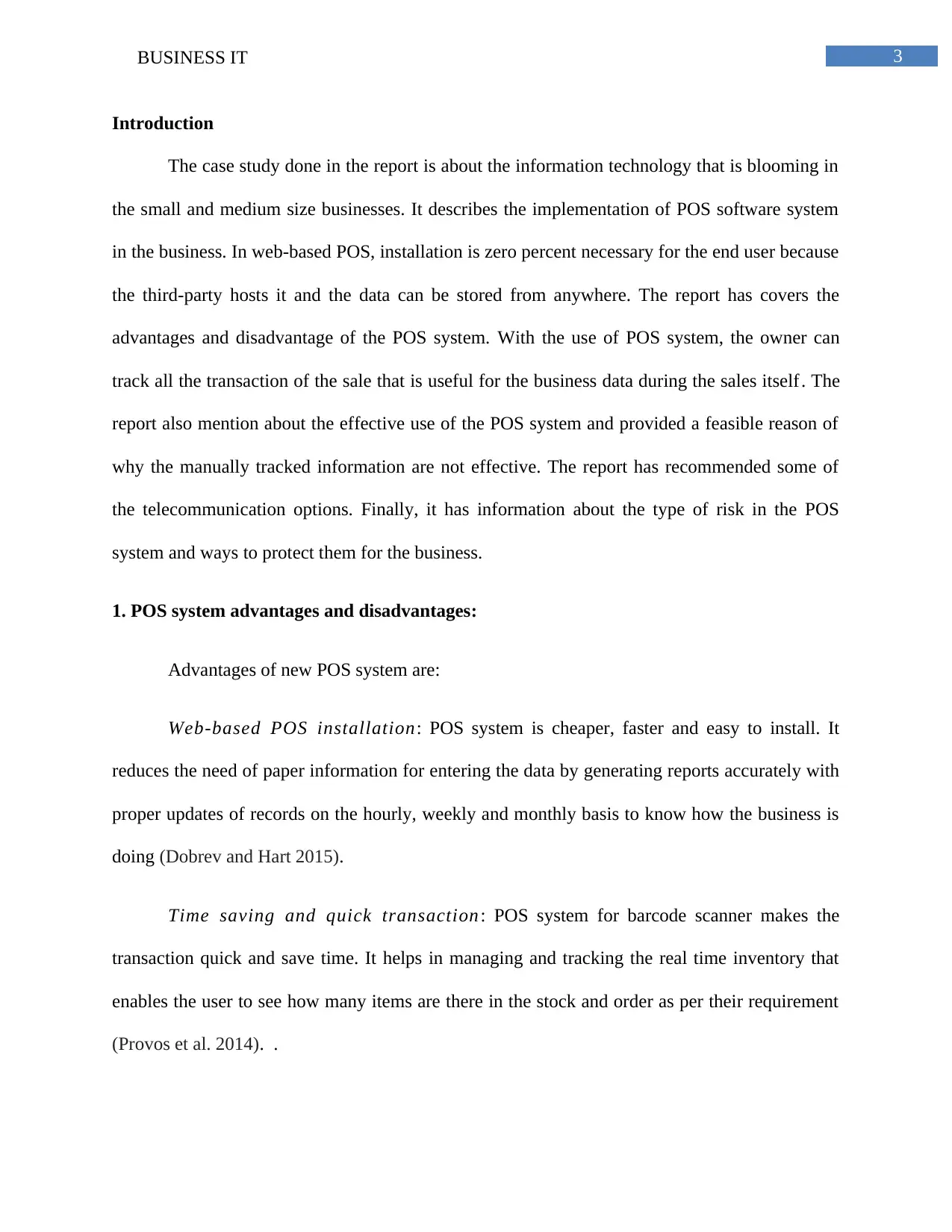
3BUSINESS IT
Introduction
The case study done in the report is about the information technology that is blooming in
the small and medium size businesses. It describes the implementation of POS software system
in the business. In web-based POS, installation is zero percent necessary for the end user because
the third-party hosts it and the data can be stored from anywhere. The report has covers the
advantages and disadvantage of the POS system. With the use of POS system, the owner can
track all the transaction of the sale that is useful for the business data during the sales itself. The
report also mention about the effective use of the POS system and provided a feasible reason of
why the manually tracked information are not effective. The report has recommended some of
the telecommunication options. Finally, it has information about the type of risk in the POS
system and ways to protect them for the business.
1. POS system advantages and disadvantages:
Advantages of new POS system are:
Web-based POS installation: POS system is cheaper, faster and easy to install. It
reduces the need of paper information for entering the data by generating reports accurately with
proper updates of records on the hourly, weekly and monthly basis to know how the business is
doing (Dobrev and Hart 2015).
Time saving and quick transaction : POS system for barcode scanner makes the
transaction quick and save time. It helps in managing and tracking the real time inventory that
enables the user to see how many items are there in the stock and order as per their requirement
(Provos et al. 2014). .
Introduction
The case study done in the report is about the information technology that is blooming in
the small and medium size businesses. It describes the implementation of POS software system
in the business. In web-based POS, installation is zero percent necessary for the end user because
the third-party hosts it and the data can be stored from anywhere. The report has covers the
advantages and disadvantage of the POS system. With the use of POS system, the owner can
track all the transaction of the sale that is useful for the business data during the sales itself. The
report also mention about the effective use of the POS system and provided a feasible reason of
why the manually tracked information are not effective. The report has recommended some of
the telecommunication options. Finally, it has information about the type of risk in the POS
system and ways to protect them for the business.
1. POS system advantages and disadvantages:
Advantages of new POS system are:
Web-based POS installation: POS system is cheaper, faster and easy to install. It
reduces the need of paper information for entering the data by generating reports accurately with
proper updates of records on the hourly, weekly and monthly basis to know how the business is
doing (Dobrev and Hart 2015).
Time saving and quick transaction : POS system for barcode scanner makes the
transaction quick and save time. It helps in managing and tracking the real time inventory that
enables the user to see how many items are there in the stock and order as per their requirement
(Provos et al. 2014). .
Paraphrase This Document
Need a fresh take? Get an instant paraphrase of this document with our AI Paraphraser
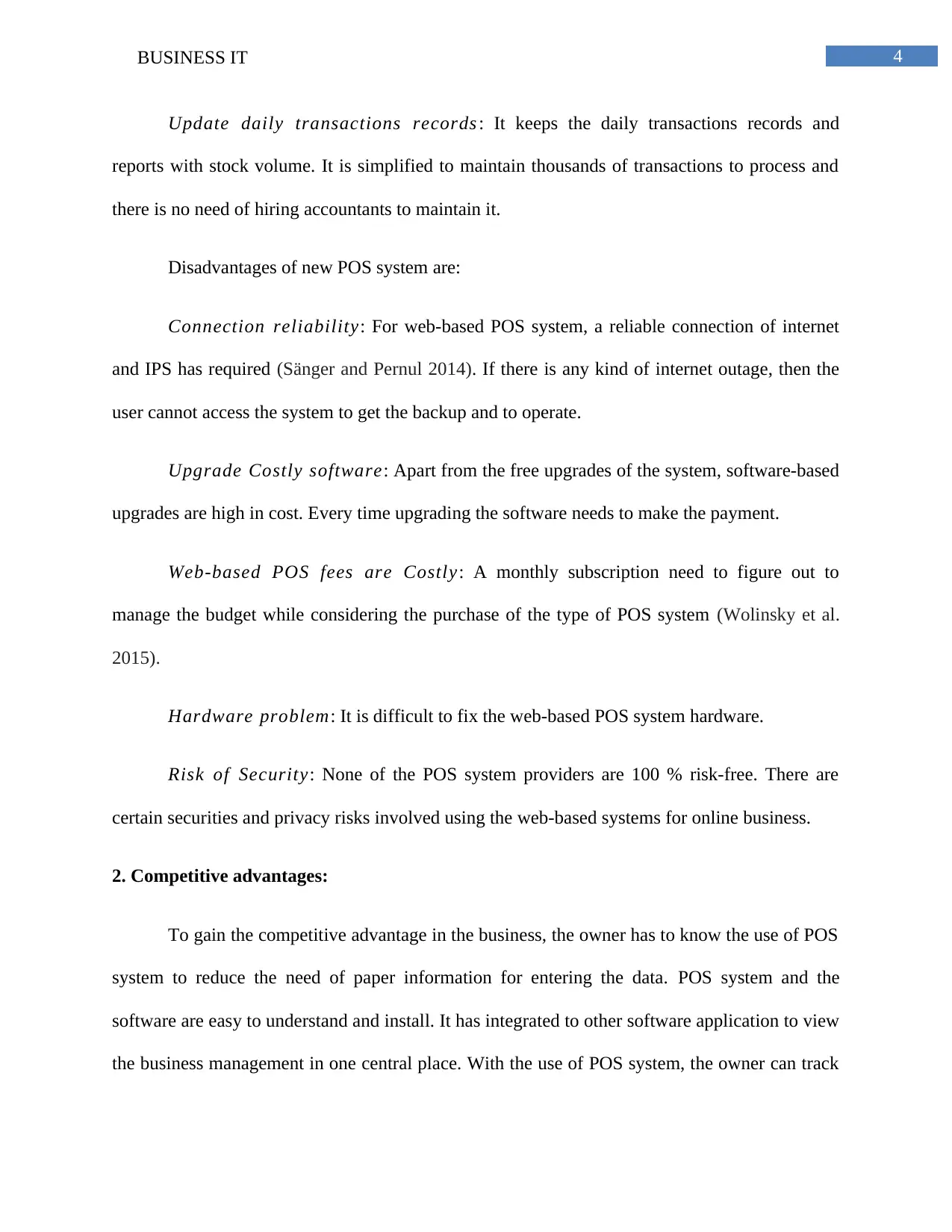
4BUSINESS IT
Update daily transactions records : It keeps the daily transactions records and
reports with stock volume. It is simplified to maintain thousands of transactions to process and
there is no need of hiring accountants to maintain it.
Disadvantages of new POS system are:
Connection reliability: For web-based POS system, a reliable connection of internet
and IPS has required (Sänger and Pernul 2014). If there is any kind of internet outage, then the
user cannot access the system to get the backup and to operate.
Upgrade Costly software: Apart from the free upgrades of the system, software-based
upgrades are high in cost. Every time upgrading the software needs to make the payment.
Web-based POS fees are Costly: A monthly subscription need to figure out to
manage the budget while considering the purchase of the type of POS system (Wolinsky et al.
2015).
Hardware problem: It is difficult to fix the web-based POS system hardware.
Risk of Security: None of the POS system providers are 100 % risk-free. There are
certain securities and privacy risks involved using the web-based systems for online business.
2. Competitive advantages:
To gain the competitive advantage in the business, the owner has to know the use of POS
system to reduce the need of paper information for entering the data. POS system and the
software are easy to understand and install. It has integrated to other software application to view
the business management in one central place. With the use of POS system, the owner can track
Update daily transactions records : It keeps the daily transactions records and
reports with stock volume. It is simplified to maintain thousands of transactions to process and
there is no need of hiring accountants to maintain it.
Disadvantages of new POS system are:
Connection reliability: For web-based POS system, a reliable connection of internet
and IPS has required (Sänger and Pernul 2014). If there is any kind of internet outage, then the
user cannot access the system to get the backup and to operate.
Upgrade Costly software: Apart from the free upgrades of the system, software-based
upgrades are high in cost. Every time upgrading the software needs to make the payment.
Web-based POS fees are Costly: A monthly subscription need to figure out to
manage the budget while considering the purchase of the type of POS system (Wolinsky et al.
2015).
Hardware problem: It is difficult to fix the web-based POS system hardware.
Risk of Security: None of the POS system providers are 100 % risk-free. There are
certain securities and privacy risks involved using the web-based systems for online business.
2. Competitive advantages:
To gain the competitive advantage in the business, the owner has to know the use of POS
system to reduce the need of paper information for entering the data. POS system and the
software are easy to understand and install. It has integrated to other software application to view
the business management in one central place. With the use of POS system, the owner can track
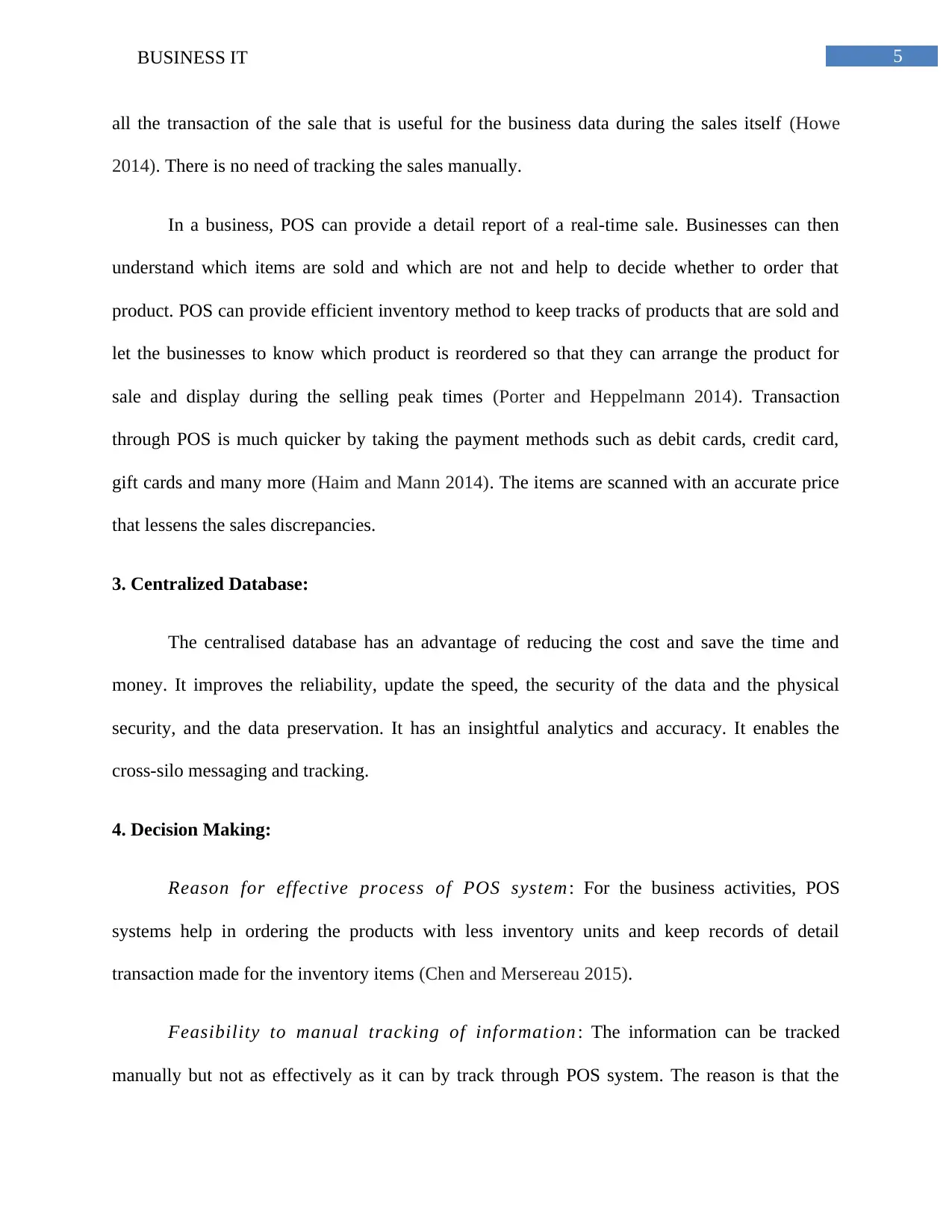
5BUSINESS IT
all the transaction of the sale that is useful for the business data during the sales itself (Howe
2014). There is no need of tracking the sales manually.
In a business, POS can provide a detail report of a real-time sale. Businesses can then
understand which items are sold and which are not and help to decide whether to order that
product. POS can provide efficient inventory method to keep tracks of products that are sold and
let the businesses to know which product is reordered so that they can arrange the product for
sale and display during the selling peak times (Porter and Heppelmann 2014). Transaction
through POS is much quicker by taking the payment methods such as debit cards, credit card,
gift cards and many more (Haim and Mann 2014). The items are scanned with an accurate price
that lessens the sales discrepancies.
3. Centralized Database:
The centralised database has an advantage of reducing the cost and save the time and
money. It improves the reliability, update the speed, the security of the data and the physical
security, and the data preservation. It has an insightful analytics and accuracy. It enables the
cross-silo messaging and tracking.
4. Decision Making:
Reason for effective process of POS system : For the business activities, POS
systems help in ordering the products with less inventory units and keep records of detail
transaction made for the inventory items (Chen and Mersereau 2015).
Feasibility to manual tracking of information : The information can be tracked
manually but not as effectively as it can by track through POS system. The reason is that the
all the transaction of the sale that is useful for the business data during the sales itself (Howe
2014). There is no need of tracking the sales manually.
In a business, POS can provide a detail report of a real-time sale. Businesses can then
understand which items are sold and which are not and help to decide whether to order that
product. POS can provide efficient inventory method to keep tracks of products that are sold and
let the businesses to know which product is reordered so that they can arrange the product for
sale and display during the selling peak times (Porter and Heppelmann 2014). Transaction
through POS is much quicker by taking the payment methods such as debit cards, credit card,
gift cards and many more (Haim and Mann 2014). The items are scanned with an accurate price
that lessens the sales discrepancies.
3. Centralized Database:
The centralised database has an advantage of reducing the cost and save the time and
money. It improves the reliability, update the speed, the security of the data and the physical
security, and the data preservation. It has an insightful analytics and accuracy. It enables the
cross-silo messaging and tracking.
4. Decision Making:
Reason for effective process of POS system : For the business activities, POS
systems help in ordering the products with less inventory units and keep records of detail
transaction made for the inventory items (Chen and Mersereau 2015).
Feasibility to manual tracking of information : The information can be tracked
manually but not as effectively as it can by track through POS system. The reason is that the
⊘ This is a preview!⊘
Do you want full access?
Subscribe today to unlock all pages.

Trusted by 1+ million students worldwide
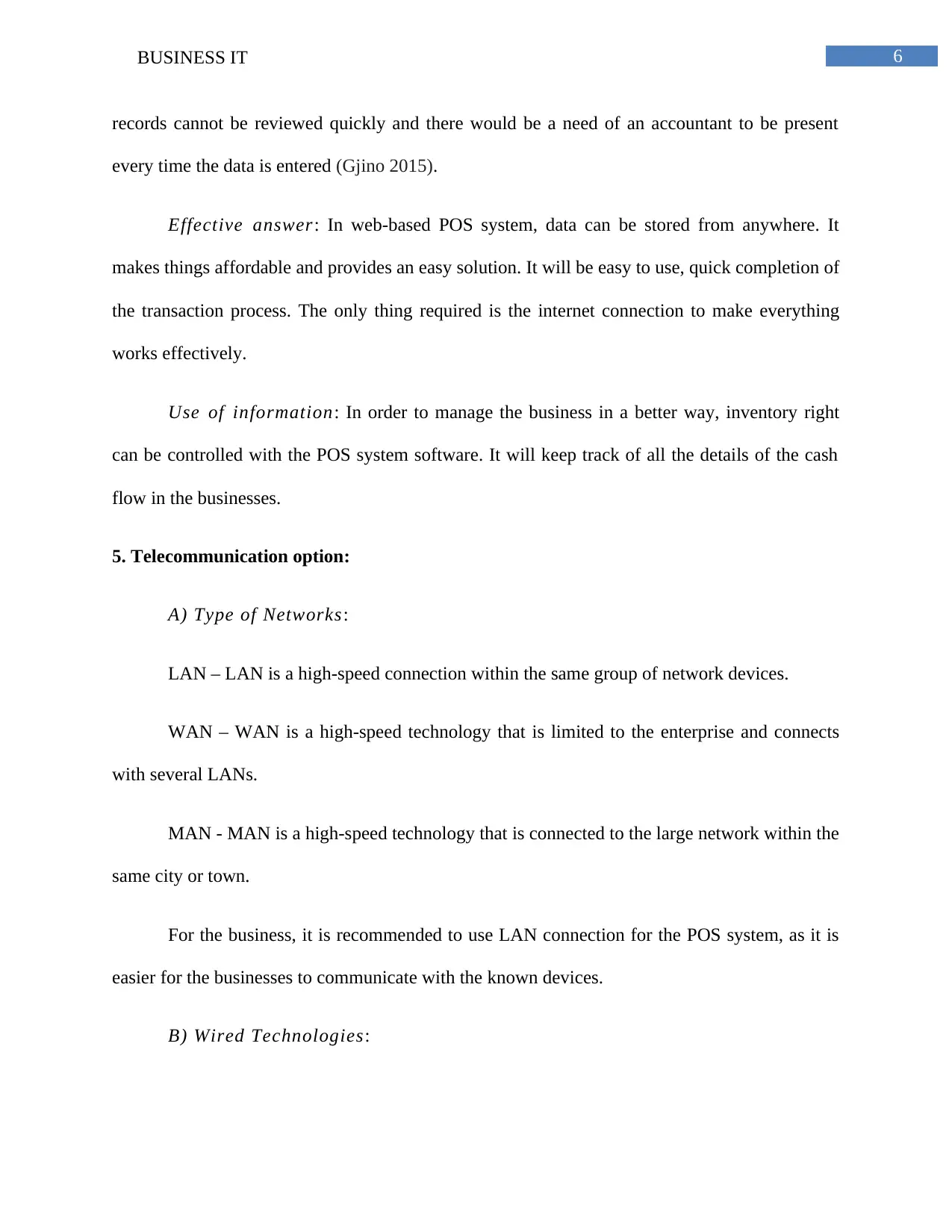
6BUSINESS IT
records cannot be reviewed quickly and there would be a need of an accountant to be present
every time the data is entered (Gjino 2015).
Effective answer: In web-based POS system, data can be stored from anywhere. It
makes things affordable and provides an easy solution. It will be easy to use, quick completion of
the transaction process. The only thing required is the internet connection to make everything
works effectively.
Use of information: In order to manage the business in a better way, inventory right
can be controlled with the POS system software. It will keep track of all the details of the cash
flow in the businesses.
5. Telecommunication option:
A) Type of Networks:
LAN – LAN is a high-speed connection within the same group of network devices.
WAN – WAN is a high-speed technology that is limited to the enterprise and connects
with several LANs.
MAN - MAN is a high-speed technology that is connected to the large network within the
same city or town.
For the business, it is recommended to use LAN connection for the POS system, as it is
easier for the businesses to communicate with the known devices.
B) Wired Technologies:
records cannot be reviewed quickly and there would be a need of an accountant to be present
every time the data is entered (Gjino 2015).
Effective answer: In web-based POS system, data can be stored from anywhere. It
makes things affordable and provides an easy solution. It will be easy to use, quick completion of
the transaction process. The only thing required is the internet connection to make everything
works effectively.
Use of information: In order to manage the business in a better way, inventory right
can be controlled with the POS system software. It will keep track of all the details of the cash
flow in the businesses.
5. Telecommunication option:
A) Type of Networks:
LAN – LAN is a high-speed connection within the same group of network devices.
WAN – WAN is a high-speed technology that is limited to the enterprise and connects
with several LANs.
MAN - MAN is a high-speed technology that is connected to the large network within the
same city or town.
For the business, it is recommended to use LAN connection for the POS system, as it is
easier for the businesses to communicate with the known devices.
B) Wired Technologies:
Paraphrase This Document
Need a fresh take? Get an instant paraphrase of this document with our AI Paraphraser
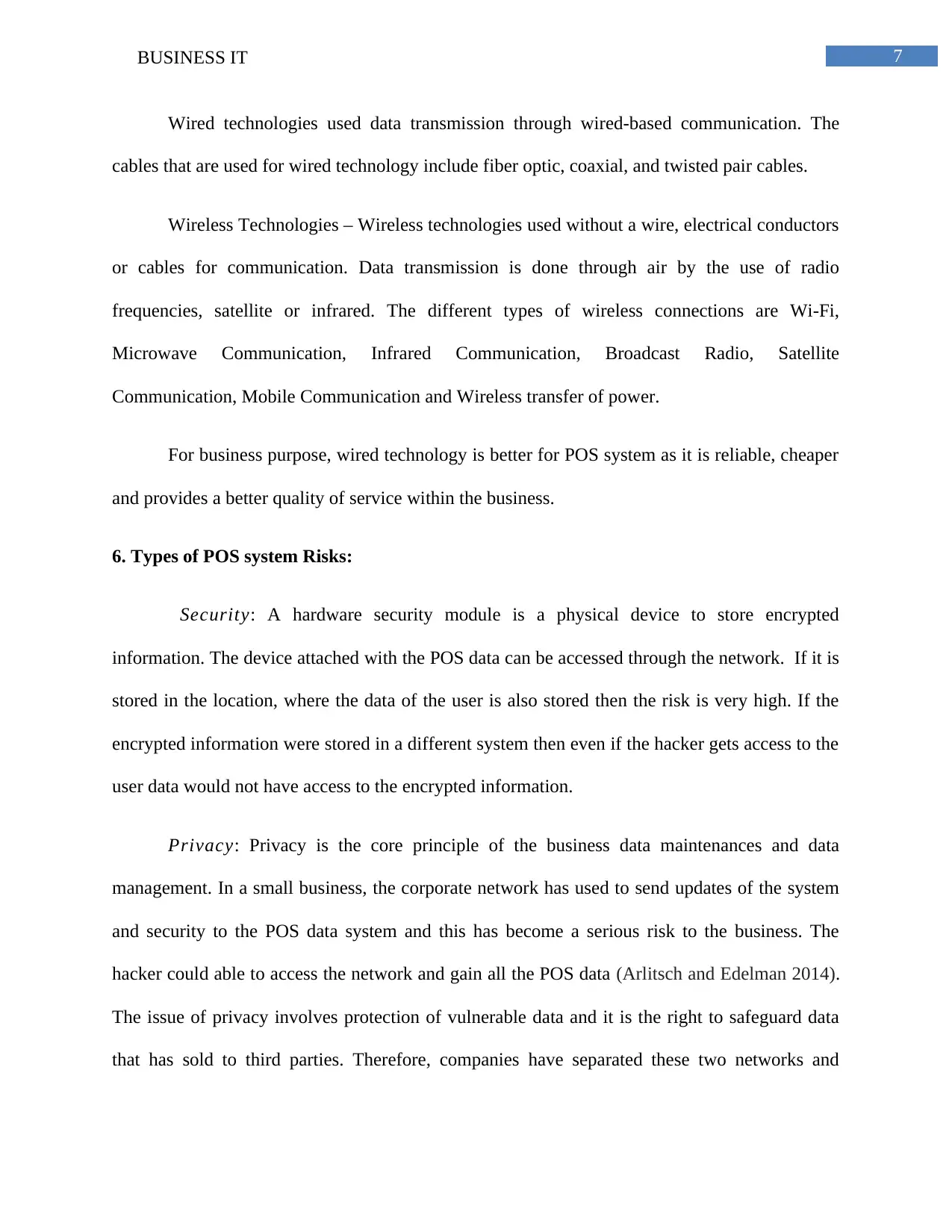
7BUSINESS IT
Wired technologies used data transmission through wired-based communication. The
cables that are used for wired technology include fiber optic, coaxial, and twisted pair cables.
Wireless Technologies – Wireless technologies used without a wire, electrical conductors
or cables for communication. Data transmission is done through air by the use of radio
frequencies, satellite or infrared. The different types of wireless connections are Wi-Fi,
Microwave Communication, Infrared Communication, Broadcast Radio, Satellite
Communication, Mobile Communication and Wireless transfer of power.
For business purpose, wired technology is better for POS system as it is reliable, cheaper
and provides a better quality of service within the business.
6. Types of POS system Risks:
Security: A hardware security module is a physical device to store encrypted
information. The device attached with the POS data can be accessed through the network. If it is
stored in the location, where the data of the user is also stored then the risk is very high. If the
encrypted information were stored in a different system then even if the hacker gets access to the
user data would not have access to the encrypted information.
Privacy: Privacy is the core principle of the business data maintenances and data
management. In a small business, the corporate network has used to send updates of the system
and security to the POS data system and this has become a serious risk to the business. The
hacker could able to access the network and gain all the POS data (Arlitsch and Edelman 2014).
The issue of privacy involves protection of vulnerable data and it is the right to safeguard data
that has sold to third parties. Therefore, companies have separated these two networks and
Wired technologies used data transmission through wired-based communication. The
cables that are used for wired technology include fiber optic, coaxial, and twisted pair cables.
Wireless Technologies – Wireless technologies used without a wire, electrical conductors
or cables for communication. Data transmission is done through air by the use of radio
frequencies, satellite or infrared. The different types of wireless connections are Wi-Fi,
Microwave Communication, Infrared Communication, Broadcast Radio, Satellite
Communication, Mobile Communication and Wireless transfer of power.
For business purpose, wired technology is better for POS system as it is reliable, cheaper
and provides a better quality of service within the business.
6. Types of POS system Risks:
Security: A hardware security module is a physical device to store encrypted
information. The device attached with the POS data can be accessed through the network. If it is
stored in the location, where the data of the user is also stored then the risk is very high. If the
encrypted information were stored in a different system then even if the hacker gets access to the
user data would not have access to the encrypted information.
Privacy: Privacy is the core principle of the business data maintenances and data
management. In a small business, the corporate network has used to send updates of the system
and security to the POS data system and this has become a serious risk to the business. The
hacker could able to access the network and gain all the POS data (Arlitsch and Edelman 2014).
The issue of privacy involves protection of vulnerable data and it is the right to safeguard data
that has sold to third parties. Therefore, companies have separated these two networks and
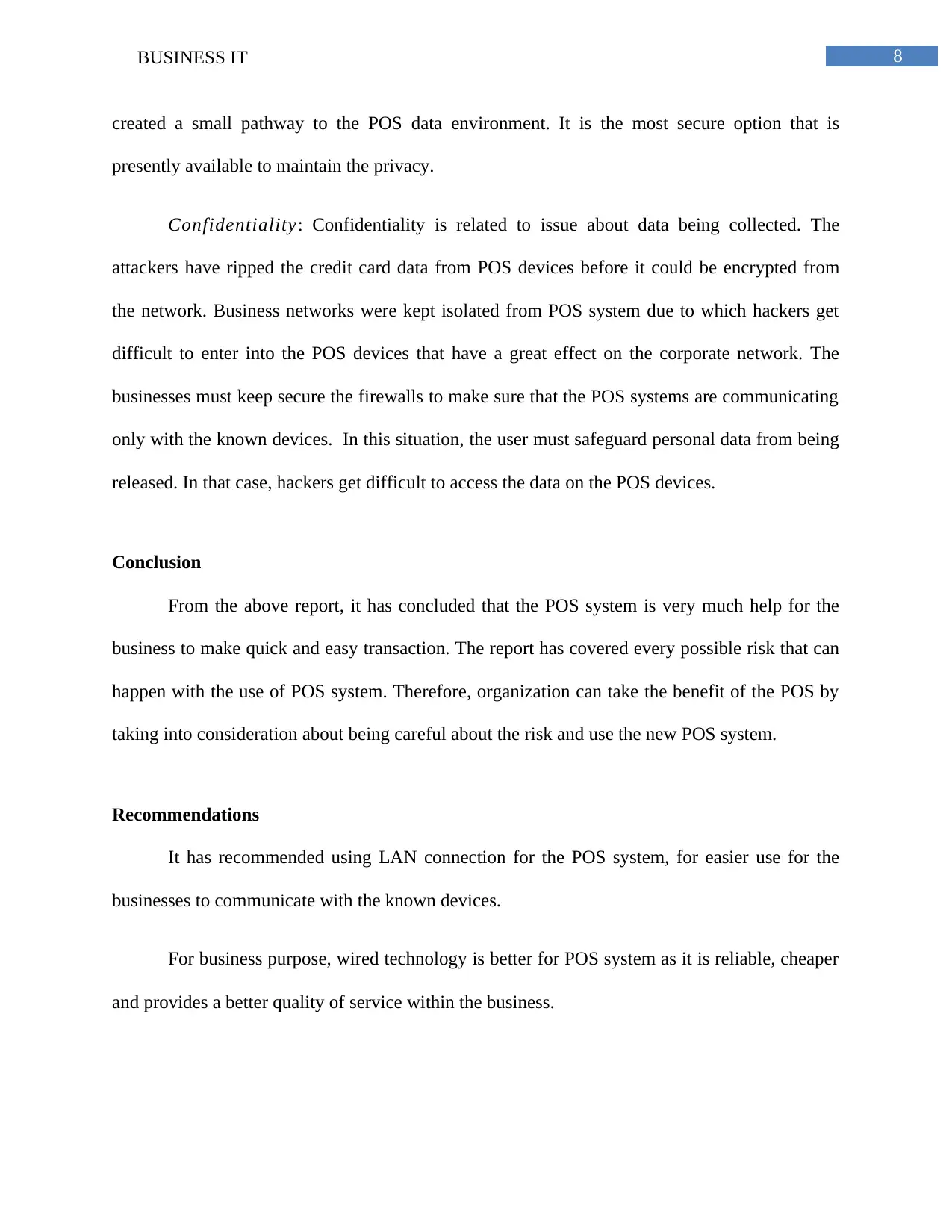
8BUSINESS IT
created a small pathway to the POS data environment. It is the most secure option that is
presently available to maintain the privacy.
Confidentiality: Confidentiality is related to issue about data being collected. The
attackers have ripped the credit card data from POS devices before it could be encrypted from
the network. Business networks were kept isolated from POS system due to which hackers get
difficult to enter into the POS devices that have a great effect on the corporate network. The
businesses must keep secure the firewalls to make sure that the POS systems are communicating
only with the known devices. In this situation, the user must safeguard personal data from being
released. In that case, hackers get difficult to access the data on the POS devices.
Conclusion
From the above report, it has concluded that the POS system is very much help for the
business to make quick and easy transaction. The report has covered every possible risk that can
happen with the use of POS system. Therefore, organization can take the benefit of the POS by
taking into consideration about being careful about the risk and use the new POS system.
Recommendations
It has recommended using LAN connection for the POS system, for easier use for the
businesses to communicate with the known devices.
For business purpose, wired technology is better for POS system as it is reliable, cheaper
and provides a better quality of service within the business.
created a small pathway to the POS data environment. It is the most secure option that is
presently available to maintain the privacy.
Confidentiality: Confidentiality is related to issue about data being collected. The
attackers have ripped the credit card data from POS devices before it could be encrypted from
the network. Business networks were kept isolated from POS system due to which hackers get
difficult to enter into the POS devices that have a great effect on the corporate network. The
businesses must keep secure the firewalls to make sure that the POS systems are communicating
only with the known devices. In this situation, the user must safeguard personal data from being
released. In that case, hackers get difficult to access the data on the POS devices.
Conclusion
From the above report, it has concluded that the POS system is very much help for the
business to make quick and easy transaction. The report has covered every possible risk that can
happen with the use of POS system. Therefore, organization can take the benefit of the POS by
taking into consideration about being careful about the risk and use the new POS system.
Recommendations
It has recommended using LAN connection for the POS system, for easier use for the
businesses to communicate with the known devices.
For business purpose, wired technology is better for POS system as it is reliable, cheaper
and provides a better quality of service within the business.
⊘ This is a preview!⊘
Do you want full access?
Subscribe today to unlock all pages.

Trusted by 1+ million students worldwide
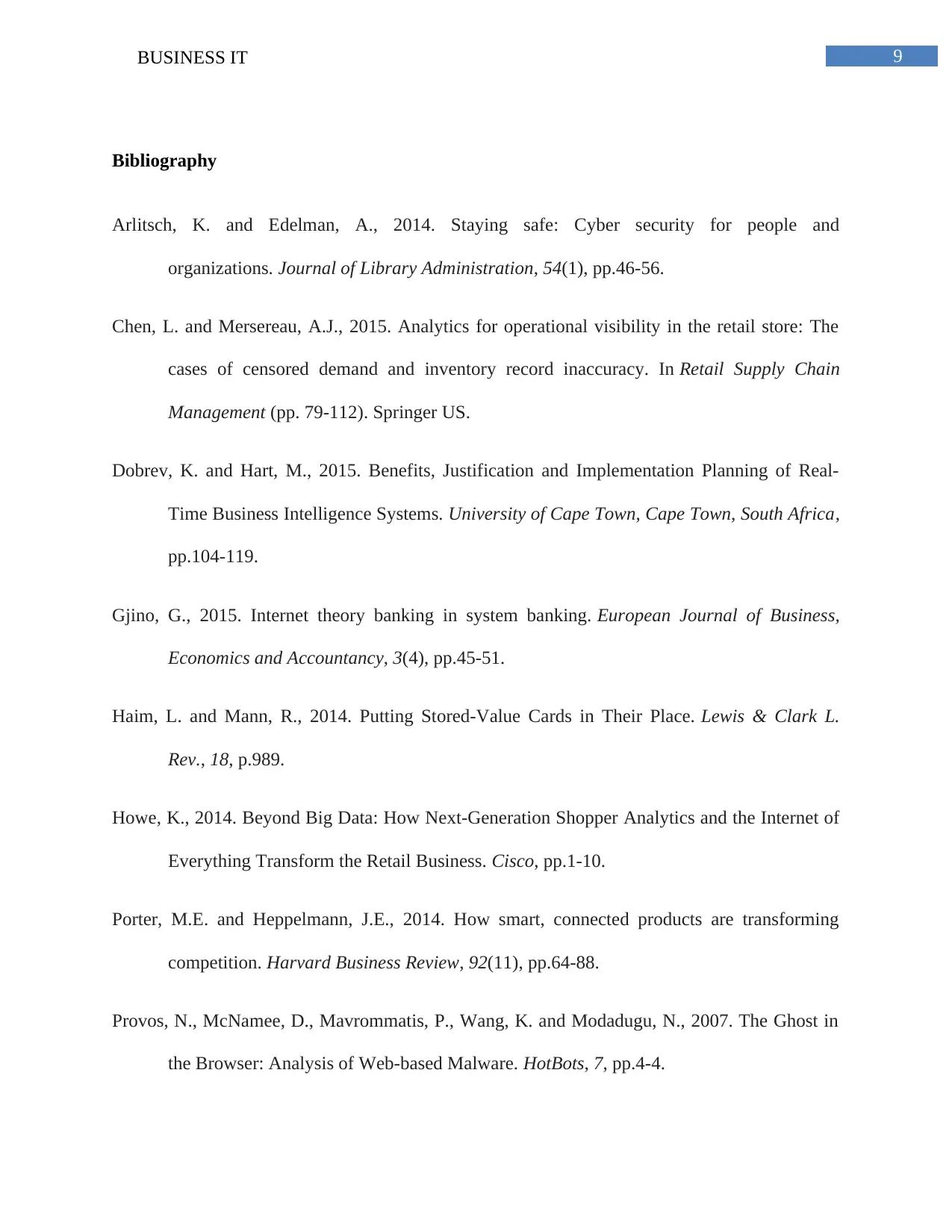
9BUSINESS IT
Bibliography
Arlitsch, K. and Edelman, A., 2014. Staying safe: Cyber security for people and
organizations. Journal of Library Administration, 54(1), pp.46-56.
Chen, L. and Mersereau, A.J., 2015. Analytics for operational visibility in the retail store: The
cases of censored demand and inventory record inaccuracy. In Retail Supply Chain
Management (pp. 79-112). Springer US.
Dobrev, K. and Hart, M., 2015. Benefits, Justification and Implementation Planning of Real-
Time Business Intelligence Systems. University of Cape Town, Cape Town, South Africa,
pp.104-119.
Gjino, G., 2015. Internet theory banking in system banking. European Journal of Business,
Economics and Accountancy, 3(4), pp.45-51.
Haim, L. and Mann, R., 2014. Putting Stored-Value Cards in Their Place. Lewis & Clark L.
Rev., 18, p.989.
Howe, K., 2014. Beyond Big Data: How Next-Generation Shopper Analytics and the Internet of
Everything Transform the Retail Business. Cisco, pp.1-10.
Porter, M.E. and Heppelmann, J.E., 2014. How smart, connected products are transforming
competition. Harvard Business Review, 92(11), pp.64-88.
Provos, N., McNamee, D., Mavrommatis, P., Wang, K. and Modadugu, N., 2007. The Ghost in
the Browser: Analysis of Web-based Malware. HotBots, 7, pp.4-4.
Bibliography
Arlitsch, K. and Edelman, A., 2014. Staying safe: Cyber security for people and
organizations. Journal of Library Administration, 54(1), pp.46-56.
Chen, L. and Mersereau, A.J., 2015. Analytics for operational visibility in the retail store: The
cases of censored demand and inventory record inaccuracy. In Retail Supply Chain
Management (pp. 79-112). Springer US.
Dobrev, K. and Hart, M., 2015. Benefits, Justification and Implementation Planning of Real-
Time Business Intelligence Systems. University of Cape Town, Cape Town, South Africa,
pp.104-119.
Gjino, G., 2015. Internet theory banking in system banking. European Journal of Business,
Economics and Accountancy, 3(4), pp.45-51.
Haim, L. and Mann, R., 2014. Putting Stored-Value Cards in Their Place. Lewis & Clark L.
Rev., 18, p.989.
Howe, K., 2014. Beyond Big Data: How Next-Generation Shopper Analytics and the Internet of
Everything Transform the Retail Business. Cisco, pp.1-10.
Porter, M.E. and Heppelmann, J.E., 2014. How smart, connected products are transforming
competition. Harvard Business Review, 92(11), pp.64-88.
Provos, N., McNamee, D., Mavrommatis, P., Wang, K. and Modadugu, N., 2007. The Ghost in
the Browser: Analysis of Web-based Malware. HotBots, 7, pp.4-4.
Paraphrase This Document
Need a fresh take? Get an instant paraphrase of this document with our AI Paraphraser
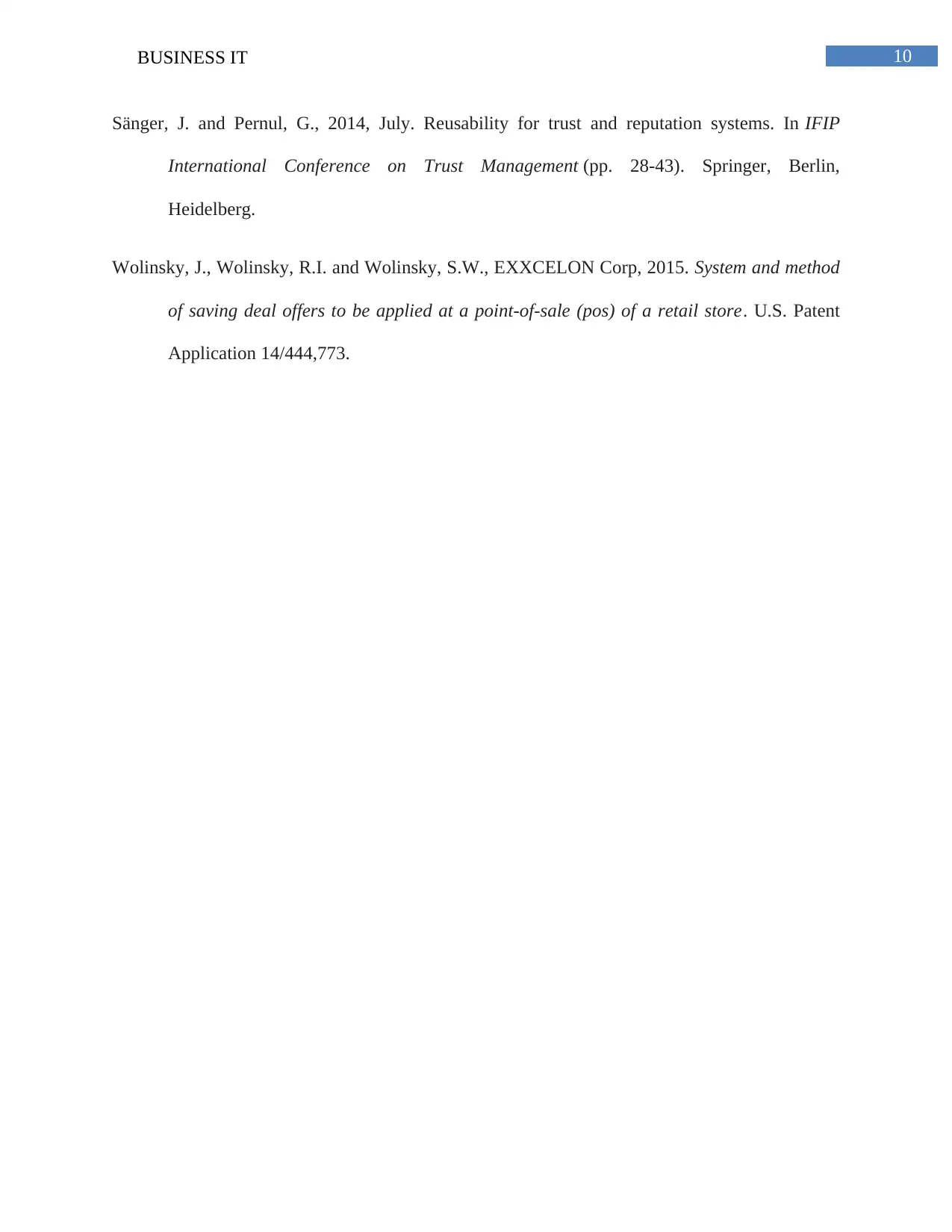
10BUSINESS IT
Sänger, J. and Pernul, G., 2014, July. Reusability for trust and reputation systems. In IFIP
International Conference on Trust Management (pp. 28-43). Springer, Berlin,
Heidelberg.
Wolinsky, J., Wolinsky, R.I. and Wolinsky, S.W., EXXCELON Corp, 2015. System and method
of saving deal offers to be applied at a point-of-sale (pos) of a retail store. U.S. Patent
Application 14/444,773.
Sänger, J. and Pernul, G., 2014, July. Reusability for trust and reputation systems. In IFIP
International Conference on Trust Management (pp. 28-43). Springer, Berlin,
Heidelberg.
Wolinsky, J., Wolinsky, R.I. and Wolinsky, S.W., EXXCELON Corp, 2015. System and method
of saving deal offers to be applied at a point-of-sale (pos) of a retail store. U.S. Patent
Application 14/444,773.
1 out of 11
Related Documents
Your All-in-One AI-Powered Toolkit for Academic Success.
+13062052269
info@desklib.com
Available 24*7 on WhatsApp / Email
![[object Object]](/_next/static/media/star-bottom.7253800d.svg)
Unlock your academic potential
Copyright © 2020–2025 A2Z Services. All Rights Reserved. Developed and managed by ZUCOL.





